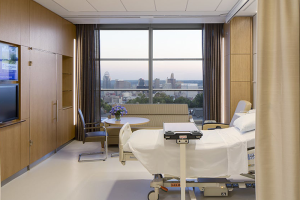Mercy Hospital Jefferson wraps up expansion and renovation project
Mercy Hospital Jefferson recently wrapped up an extensive expansion and renovation project. The Crystal City, Mo., campus built a new three-story, 120,000-sq.-ft. patient building that features 90 private patient rooms.
The $73 million tower was constructed to the south of the existing hospital facility and is designed to accommodate a potential vertical expansion to add new patient floors in the future.
The project also involved major renovations. The hospital’s main entrance was redesigned to improve patient and visitor access. It now features a covered canopy, full window lantern element, reflecting pond, and stone and brick façade. Inside, patients and visitors experience improved wayfinding and new corridors that efficiently connect the emergency department, imaging, surgical services and admitting areas.
Additional interior renovations of the existing hospital building included:
- Construction of a new emergency department waiting area and triage rooms
- Additional cardiology facilities
- New MRI suites
- New childbirth center with labor and delivery suites
- Remodeled postpartum rooms
- Two OBGYN surgical units
Other enhancements to the Crystal City, Mo., campus include relocation of the emergency helicopter landing pad and ambulance entrance as well as a parking expansion and repaving of Emergency Drive, which loops through the hospital property.
All construction activities progressed while the 251-bed hospital continued to provide full services to patients and the community. McCarthy Building Cos. Inc. served as the project’s construction manager.
“Delivering a significant construction project on an active medical campus requires constant communication with hospital staff, patients and the community,” says John Farnen, executive director of strategic projects for Mercy. “Mercy has worked with McCarthy for more than 30 years, and we rely on their health care expertise and ability to minimize disruptions throughout construction.”
The construction team leveraged building information modeling for mechanical, electrical and plumbing (MEP) coordination, to facilitate construction efficiency and accuracy.
Bates Architects designed the new patient tower and Heideman Associates served as MEP engineer.




